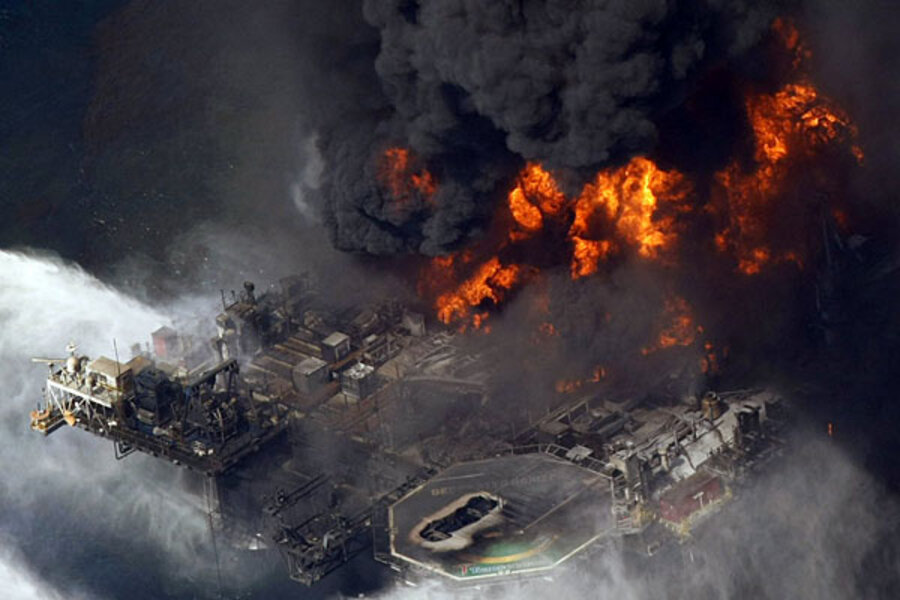Gulf oil spill: failure of blowout preventer traced to bent drill pipe
Loading...
Two days after explosions ripped the Deepwater Horizon, the drilling rig's last line of defense against disaster – a massive 300-ton blowout preventer sitting on the ocean floor – was finally triggered. But it failed by inches.
No human was to blame for the blowout preventer's failure to stop the Gulf oil spill, according to a team of Norwegian undersea oil-equipment experts who spent six months investigating why the "fail-safe" device did not work.
Why the blowout preventer didn’t work has been the subject of intense speculation and several congressional and private investigations. The primary cause for that failure, according to the Norwegian consulting firm Det Norske Veritas, was the blowout preventer's "blind-shear ram" – a massive set of steel jaws intended to completely cut through the drill pipe, crimping it in the process and sealing the well.
The reason the shear ram's jaws failed was because they encountered a situation for which they were not designed – a "buckled" section of drill pipe, bowed sideways by the enormous pressure of oil thrusting upward from miles beneath the earth, the investigators said in their final report to the Interior Department and the US Coast Guard, which was released Wednesday.
At 7:30 a.m. on April 22 last year, less than an hour before the Deepwater Horizon sank to the bottom of the Gulf of Mexico, a remote-operated vehicle (ROV) finally was able to activate the shear ram's hydraulic system, the report says. At that point, a 25-second-long process began as the system's steel jaws began to close on the pipe.
But as those blades closed, "the drill pipe was positioned such that the outside corner of the upper [blind-shear ram] blade contacted the drill pipe slightly off center of the drill pipe cross section," investigators found. As a result, part of the pipe was not sheared through as expected. "As the [shear ram blades] closed, a portion of the drill pipe cross section became trapped between the ram block faces, preventing the blocks from fully closing and sealing."
Even with eight hydraulic canisters supplying 4,000 pounds per square inch of hydraulic pressure, the blowout preventer's most potent set of steel jaws stalled (although it did close to within two inches of success). It just did not have the 4,273 psi that investigators estimated were needed to close that tiny gap and prevent America’s largest offshore oil spill, the investigators found.
Ultimately, investigators reported that they could not be 100 percent sure when the blind-shear ram was activated, but they found it highly unlikely that the system closed when the crew tried to trigger it before abandoning ship. Even so, because the drill pipe was bent "from the moment the well began flowing," the result would have been the same, the report said.
"In the partially closed position, flow would have continued through the drill pipe trapped between the ram block faces and subsequently through the gaps between the ram blocks," investigators concluded. When the drill pipe was sheared later on April 29, using a different slicing mechanism, the blowout preventer's casing shear rams, "the well flow pattern changed to a new exit point."
Besides the "primary cause," investigators identified several other blowout-preventer design problems – including one questionable procedure as well as one subpar industry standard that they said should be addressed "in the design of future blowout preventers and the need for modifying current blowout preventers."
• Buckling pipe: "The elastic buckling of drill pipe was a direct factor that prevented the [blind-shear ram] from closing and sealing the well."
• Off-center flaw: "The inability of the blind shear ram to shear the off-center drill pipe contributed to the blind shear ram's being unable to close and seal the well."
• Sequence of other systems: "The timing and sequence of closing [other blowout-preventer closing mechanisms] contributed to the drill pipe segment buckling and bowing between the two moving the drill pipe off center."
• Control systems: Testing of the blowout preventer's systems "indicated some back-up control system components did not perform as intended," including its control pods and communications system.
• ROV weaknesses: "The ROV intervention efforts reviewed indicated the ROVs were not capable of directly and rapidly determining the status of various ROV components."
• Backup system standard: "A review of industry standards indicated they do not stipulate performance requirements for back-up systems (e.g. closing response times) as they do for primary control systems."
Still, the bottom line was clear: While the blind-shear ram was activated by an ROV two days after the disaster began, the powerful hydraulic piston "failed to fully close and seal due to a portion of drill pipe trapped between" the blocks.
"It is recommended the industry examine and study the ability of the shear rams to complete their intended function of completely cutting tubulars regardless of their position within the well bore, and sealing the well," the report said.
Some close observers of the blowout-preventer issue in Congress said the report showed that a complete review of blowout preventers is needed since they appear capable of failing under pressure in a crisis situation.
“The spill commission’s report said that the problems within the oil industry that led to the BP spill were systemic, and not unique to this disaster,” said Rep. Edward Markey (D) of Massachusetts. “Now we know there could also be systemic design issues with blowout preventers that could cause them to be ineffective, even when deployed as intended. We need a full review of every single blowout preventer used in United States waters, and revisit the designs of these supposed machines of last resort.”





